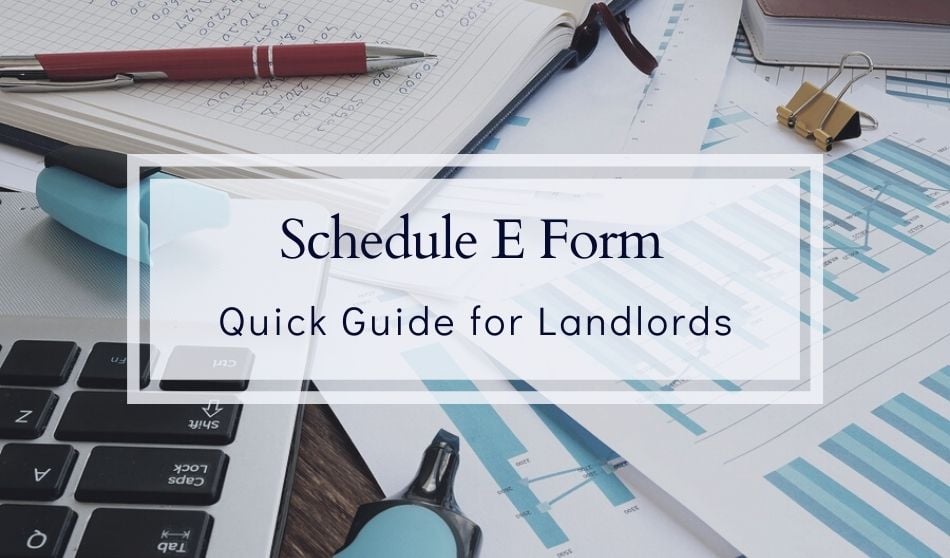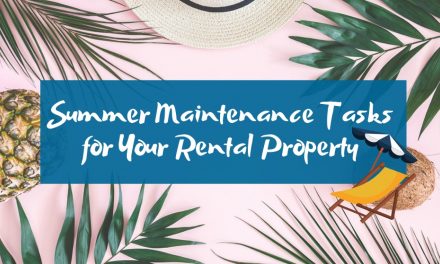
With the new year just ahead and tax season fast approaching, it’s a good time to start thinking about end-of-year bookkeeping tasks to help you prepare to complete tax forms such as the Schedule E.
If this is your first year renting out a property or just need a refresher, this article will outline the IRS Schedule E form, who needs to fill it, what it documents, and how to prepare your bookkeeping to accommodate the requirements.
How does the IRS know I have rental income?
The Internal Revenue Service (IRS) has outlined specific requirements to document all forms of rental income. And, depending on the type management of rentals, income type, and other factors determines the forms they will require you to submit.
Note: This article is not intended to provide any legal or tax advice but is provided for informational purposes only. Seek professional council from your accountant or financial advisor regarding your unique tax requirements.
Schedule E vs Schedule C forms
The IRS divides income into either passive income or active income categories.
Passive income is what they call “supplemental income” and active income is generated from business activities (also known as earned income).
Both Schedule E and Schedule C forms are part of IRS Form 1040. Passive income is documented on a Schedule E and active income is general documented on a Schedule C and/or other tax forms.
Schedule C Form
Schedule C forms are used by businesses (including business entities such as a sole proprietor) to document profits and losses from business activities. A property management company or professional landlord is likely to use the Schedule C form.
The IRS explains that the activity qualifies as a business if:
- Your primary purpose for engaging in the activity is for income or profit.
- You are involved in the activity with continuity and regularity.
Work with your accountant to determine if your activity qualifies or if you need to fill out the Schedule E form instead.
Schedule E Form
Schedule E forms are used primarily by individuals to report income or loss from supplemental income where you did not materially participate in the business activity. For example, a limited partnership in most cases isn’t likely to have materially participated in the rental activity.
So basically, you need to determine if your rental activity is passive or active to determine which form to use.
Fortunately, the IRS provides clear guidelines in their publications.
They outline what activities are and are not passive and highlight exceptions for certain rental real estate activities. It is recommended to not only review the below resources but also to reach out to your financial advisor to ensure you not only choose the correct form but are also preparing your end-of-year documents correctly.
- About Schedule C (Form 1040) | Profit or Loss from Business
- Instructions for Schedule E | Supplemental Income and Loss
- Information and link to the IRS Publication 925 | Passive Activity and At-Risk Rules
Note: The IRS also provides topics and additional publications specific to the rental industry. For example: Topic No. 415 Renting Residential and Vacation Property outlines how to calculate rental income and loss when your rental is also used as a residence for personal purposes so be sure to check out the IRS Tax Topics and Publications available:
IRS Tax Topics
IRS Forms, Instructions & Publications
For those that will be completing a Schedule E form for the upcoming tax season, let’s review that form and helpful tips and information.
Schedule E form Part One
For the majority of private landlords, you’ll likely only need to complete Part One of the Schedule E tax form. In the first section of the Schedule E (Form 1040) you’ll be listing the following information:
Line 1
Physical address of each property and Schedule E property types. The property types available are Single Family Residence, Multi-Family Residence, Vacation/Short-Term Rental, Commercial and also,
Land: Speak to your accountant if you lease or rent land and ask how depreciation and other nuances are handled when it comes to filling out any tax forms.
Royalties: If you mark this section here, you’ll be entering royalties received on line 4. Again, your accountant can walk you through how to complete this form if you receive royalties of any type.
Self-Rental: Property rented to a trade or business (check with the IRS and tax advisor for details)
Other: If you have property that isn’t one of the above types, you will be required to attach a statement describing the property that you consider ‘other’. Then, your return will need to be manually filed as attachments are not allowable when e-filing.
Line 2
Rental and personal use days – enter then number of days the property was rented and the number of days the property was used for personal use.
Line 3
Enter the total amount of rent received for each property (property A, B, and C). For more than three properties, you will need to fill out additional Schedule E forms.
Line 4
Enter royalties received (see section one – property type above)
Lines 5-17 are where you’ll list the expenses you paid out related to each property.
Those expense categories are:
- Advertising
- Auto and travel expenses
- Cleaning and maintenance
- Commissions
- Insurance
- Legal and other professional fees
- Management fees
- Mortgage interest paid to banks, etc.
- Other interest
- Repairs
- Supplies
- Taxes
- Utilities
- Depreciation expense or depletion (there are forms to calculate depreciation such as the Form 4562)
- Other (a placeholder for you to insert any additional expenses).
Note: Do not add car or equipment rental as an expenses on a Schedule E form. For those required to fill out a Schedule C or C-EZ, you can list car and equipment rental expenses there.
From there, the form will walk you through calculations of total expenses and income per property, deductible losses (see form instructions and Form 8582), and other calculations.
If you have more than three properties, fill out a form lines for every three properties and then decide which form you’ll use to calculate the totals for lines 23-26 and Part Five (see below).
Page Two of the Schedule E form
The second page of the Schedule E form is for documenting information such as:
Part II — Income or Loss From Partnerships and S Corporations
Part III — Income or Loss From Estates and Trusts
Part IV — Income or Loss from Real Estate Mortgage Investment Conduits (REMICs) – Residual Holder
Part V — Summary which includes the totals from all the parts above plus information about farming and fishing income and real estate professionals rental real estate activity (materially participated) that fell under the passive activity loss rule (see resource link for IRS Publication 925 above) .
For more information on qualified joint ventures, special partnership cases, S Corporations, here: Schedule E for Supplemental Income and Loss Explained
Note: there are rules regarding how much passive activity loss is claimable. Those limits are based on your adjusted gross income (AGI). For example, if the your AGI is less than $100,000 you are able to claim $25,000 towards loss. If the AGI is too high you won’t be able to take that loss on the Schedule E but will be able to use form 8582 and carry that loss forward.
Whether you are calculating depreciation, your adjusted gross income, or filling out any tax documentation such as a Schedule E form, check with the IRS publications for the most up-to-date information and your accountant for specific instructions based on your unique situation.
Conclusion
These IRS forms may feel daunting but there is help! Gathering the details of expenses and income per category and per property can be very time consuming. Having a CPA or bookkeeper do the extra work of calculating that information is very expensive. You can save both time and money by using great landlord software that incorporates Schedule E categories and reports.
The small investment in landlord software can basically pay for itself in time savings by automatically categorizing designated Schedule E items. Pull a Schedule E report per property with a push of a button – use the report yourself or email it directly to your accountant. That time saved plus the useful tools to manage your properties, communicate with your tenants, automate rental payments, and much more – makes using rental management software a smart move.





